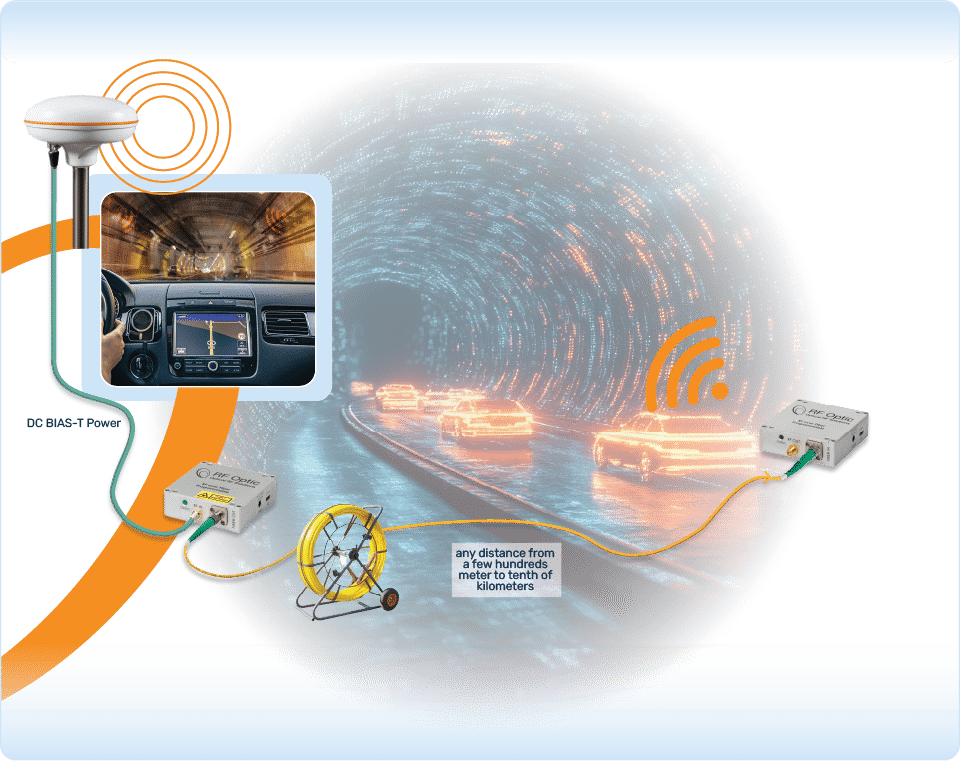
RF over Fiber for GPS/GNSS
This application note outlines the use of RF over fiber technology for Global Navigation Satellite System (GNSS) applications, emphasizing its benefits in maintaining signal integrity and precision in GPS systems. This advanced optical RF solution is crucial for enhancing the performance of GNSS receivers in various environmental conditions and applications.
Why use RF over Fiber and not coax in GNSS?
A growing demand for 5G and 6G RF over Fiber testing is driven by the need for higher frequency and bandwidth coverage, long-distance performance and increased dynamic range. These systems are designed for base station and interoperability test sites, feature remote management and configuration that enable test automation. RFOptic has developed advanced RFoF systems that focus on high dynamic range performance and are optimized to address critical test criteria including EVM and ACLR over the ever-widening channel bandwidths. RFOptic’s 5G and 6G solutions are delivered in a 2U high-density platform, capable of housing up to 20 bidirectional terminals or up to 40 transmitters or receivers in each enclosure. This compact design is modular using hot-swappable 5 drawers that allow for flexible configuration supporting common or separate RF up and down link ports as well as single or multiplexed fiber ports. The remote management interface provides full automation API. It auto-configures itself to the hardware, enhancing operational efficiency and convenience.
General GNSS RF over Fiber characteristics
The RF over fiber system includes outdoor and indoor units equipped to handle a wide range of RF frequencies, typically from 0.1 GHz to several GHz, tailored to meet the specific needs of GNSS applications. The system is designed for optimal reliability, offering low noise figures and high linearity to ensure precise signal transmission.
A look at coverage & frequencies
With the rapid evolution of the RF high-frequency market due to 5G and 6G advancements, customers seek integrated, end-to-end solutions. RF over Fiber offers significant benefits, including handling wider QAM encoding such as QAM 1024 and wider modulation bandwidths of 200MHz and 400MHz requiring very high spurious-free dynamic range (SFDR)..
GNSS RF over Fiber Use case – application & design
In GNSS applications, the RF over fiber system connects antennas positioned outdoors with receivers located indoors or at remote monitoring stations. This setup allows for optimal antenna placement while minimizing signal degradation. The system design incorporates features such as optical signal management and signal conditioning to maintain high signal integrity.
Description of the GNSS RF over Fiber system
The RF over fiber system for GNSS consists of outdoor units that house the antennas and optical transmitters and indoor units that contain receivers and signal processing equipment. This configuration allows for efficient transmission of RF signals converted to optical signals, which are then transmitted over fiber optics. The optical signals are converted back to RF signals at the receiving end, preserving signal quality. RFOptic also provides a fully integrated GNSS/GPS over fiber optics system that offers a completely transparent cross-site connection between an antenna and a receiver. Optical fiber provides a cost-effective solution for long coaxial cable runs in GNSS/GPS timing distribution systems.
The RFOptic GNSS/GPS over Fiber Optics system allows signals to be carried from an antenna to a GNSS/GPS receiver with minimal signal degradation over a non-conducting dielectric glass media. As is the case in many types of in-building environments, networks require accurate clock synchronization. By utilizing broadband analog or RF over Fiber Optics (RFoF) technology, RFOptic GNSS/GPS over Fiber Optics links provide easy-to-operate, low-cost, and reliable solutions that enable GNSS/GPS signal distribution using fiber optic cable. The broad bandwidth (20 MHz to 3.0 GHz) of the RFoF transceivers used in RFOptic’s GNSS/GPS over Fiber Optics link allows transmission of the two main signals in the GNSS/GPS band, L1 and L2, at 1575.42 MHz and 1227.6 MHz, respectively.
RFoF Monitoring & Control
The monitoring and control of the RF over Fiber system can be conducted through various interfaces, including Ethernet and USB, allowing for remote management and diagnostics. Visual indicators and status displays enable operators to maintain system oversight and quickly address any issues.
Large-scale GNSS RF over Fiber Case Study
In a recent deployment for a large-scale GNSS application, an engineering firm utilized RF over fiber technology to connect multiple outdoor antennas spread across a significant area to their central processing facility. This setup successfully minimized signal loss and interference, leading to enhanced positioning accuracy. As a result, the firm was able to manage a more reliable GNSS solution that improved overall operational efficiency.
Reliable GNSS RF Over Fiber System Deployment
Outdoor Units
The outdoor units are designed to be weather-resistant and robust, accommodating antennas and optical transmitters capable of operating in diverse environmental conditions.
Indoor Units
The indoor units house receivers, signal processing equipment, and monitoring systems, ensuring that the signals received are processed accurately for real-time applications.
Please note that installation is done by the customer using optical fibers with connectors. RFOptic can provide the required cable(s) upon the customer’s request.
Conclusion
The integration of RF over fiber technology in GNSS applications presents significant advantages in terms of signal integrity, flexibility, and overall performance. By utilizing this technology, users can achieve reliable and accurate GNSS positioning, making it a preferred choice for modern navigation and timing solutions. RFOptic’s GNSS solutions are tailored to meet the specific needs of customers, ensuring optimal performance in diverse applications.
Contact Us








